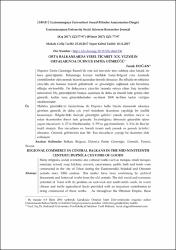| dc.contributor.author | Doğan, Faruk | |
| dc.date.accessioned | 2021-12-12T16:50:48Z | |
| dc.date.available | 2021-12-12T16:50:48Z | |
| dc.date.issued | 2017 | |
| dc.identifier.issn | 1306-732X | |
| dc.identifier.issn | 2564-680X | |
| dc.identifier.uri | https://doi.org/10.19129/sbad.330 | |
| dc.identifier.uri | https://app.trdizin.gov.tr/makale/TWprd01qWTVPUT09 | |
| dc.identifier.uri | https://hdl.handle.net/20.500.11857/2408 | |
| dc.description.abstract | Dupnice Emtia Gümrüğü Rumeli’de orta kol üzerinde tesis edilmiş olan küçük birkara gümrüğüdür. Bulunduğu konum özellikle Serez-Belgrad yolu üzerindeyürütülmekte olan pamuk ticareti açısından önemli olmuştur. Bu itibarla on sekizinciyüzyılda söz konusu ticareti geliştirmek ve güvenliğini sağlamak için kurulmuşolduğu söylenebilir. On dokuzuncu yüzyılın başında ortaya çıkan Sırp isyanlarıneticesinde Niş gümrüğünün buraya taşınması ile daha da önemli hale gelmiş olangümrük, kadim kara gümrüklerinden sayılarak 1868 tarihine kadar varlığınısürdürmüştür.Muhdes gümrüklerin kaldırılması ile Dupnice halkı büyük ekonomik sıkıntıyaÖzgirerken gümrük de daha çok yerel ürünlerin ticaretinin yapıldığı bir özellikkazanmıştır. Belgelerdeki ifadeyle gümrüğün gelirleri yörede üretilen meyve vesebze ticaretinden ibaret hale gelmiştir. İncelediğimiz dönemde gümrükte işlemyapan tüccarların % 27’ni Müslümanlar, % 59’nu gayrimüslimler, % 8’ni de Rus’larteşkil etmiştir. Rus tüccarların en önemli ticaret malı pamuk ve pamuk ürünleriolmuştur. Gümrük gelirlerinin üçte biri Rus tüccarların yaptığı bu ticaretten eldeedilmiştir. | en_US |
| dc.description.abstract | Many religious, social, economic and cultural works such as mosque, small mosque, seminary school, soup kitchen, convent, caravansary, public bath and tomb were constructed in the city of Tokat during the Danismendid, Seljukid and Ottoman periods since XIIth century. This matter have been confirming by archival documents and historical works from the old periods. The rich social and economic potential of Tokat with its position on east-west and south-north roads, its warm climate and fertile agricultural lands provided with an important contribution to being constructed of these works. As throughout the Ottoman Empire, these religious, social, economic and cultural works built in Tokat have continued their existences with the help of waqfs revenues. In this study, it will be dealt with only the waqf of Gulbahar Hatun’s Mosque from among the rich waqfs works existing in Tokat during the Ottoman period as an example study. Although there exist some studies on the waqf of Gulbahar Hatun’s Mosque, these do not examine the waqf revenues of this mosque from its beginning to today. This mosque is the only work of a sultan wife in the city-centre of Tokat. Today its waqfs revenues does not exist but it still continues its function. The sources of the study are the archival documents from that period and related research studies. The study aims to examine the waqf of Gulbahar Hatun’s Mosque as a whole and contribute to the social and economic history of Tokat. | en_US |
| dc.language.iso | tur | en_US |
| dc.relation.ispartof | Sosyal Bilimler Araştırmaları Dergisi | en_US |
| dc.identifier.doi | 10.19129/sbad.330 | |
| dc.rights | info:eu-repo/semantics/openAccess | en_US |
| dc.subject | Tarih | en_US |
| dc.title | ORTA BALKANLARDA YEREL TİCARET: XIX. YÜZYILIN ORTALARINDA DUBNİCE EMTİA GÜMRÜĞÜ | en_US |
| dc.title.alternative | REGIONAL COMMERCE IN CENTRAL BALKANS IN THE MID-NINETEENTH CENTURY: DUPN?CA CUSTOMS OF GOODS | en_US |
| dc.type | article | |
| dc.department | Fakülteler, Fen-Edebiyat Fakültesi, Tarih Bölümü | |
| dc.identifier.volume | 12 | en_US |
| dc.identifier.startpage | 77 | en_US |
| dc.identifier.issue | 2 | en_US |
| dc.identifier.endpage | 97 | en_US |
| dc.relation.publicationcategory | Makale - Ulusal Hakemli Dergi - Kurum Öğretim Elemanı | en_US |
| dc.institutionauthor | Doğan, Faruk | |



















